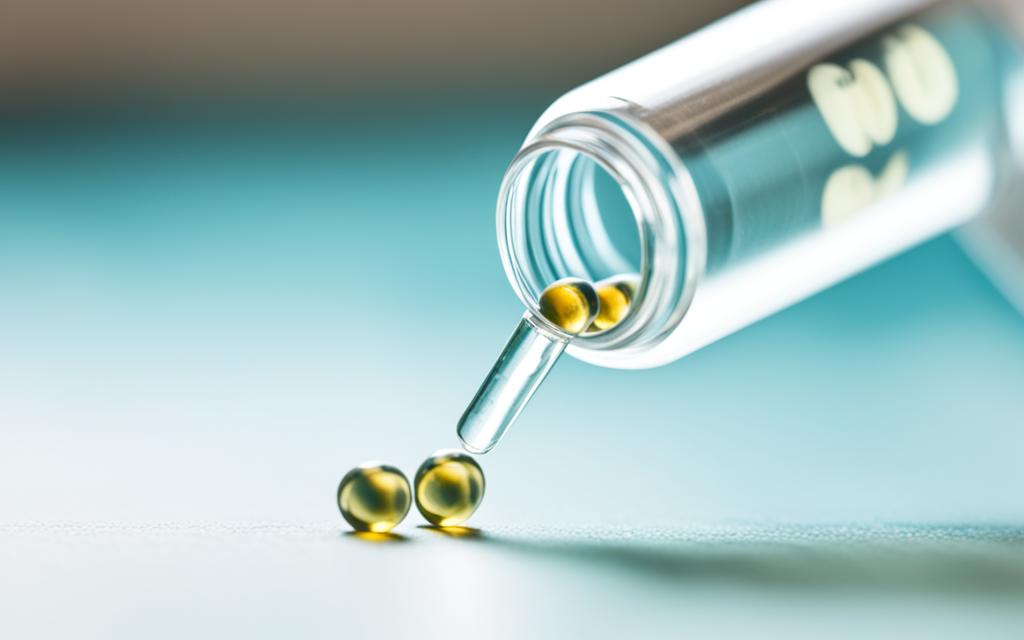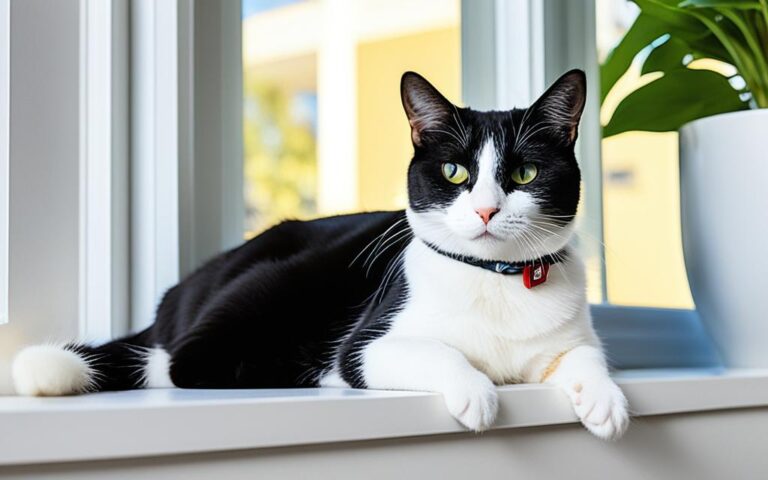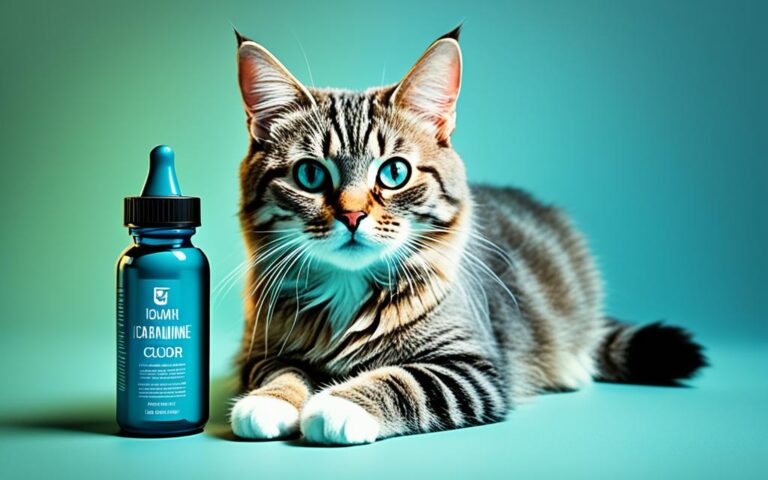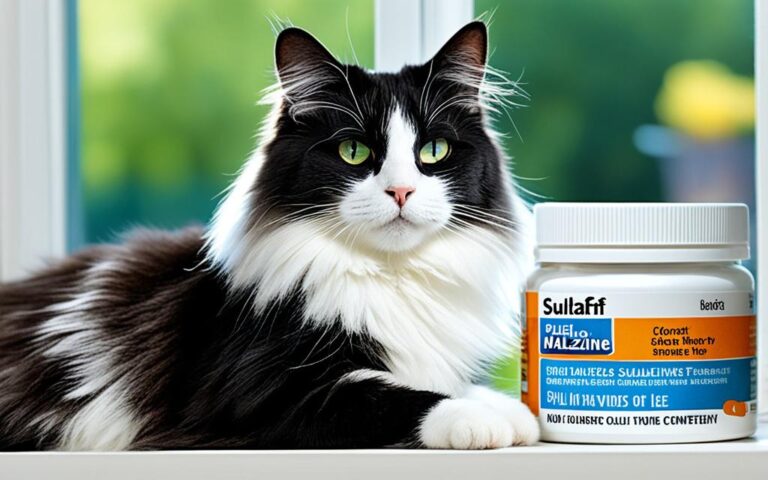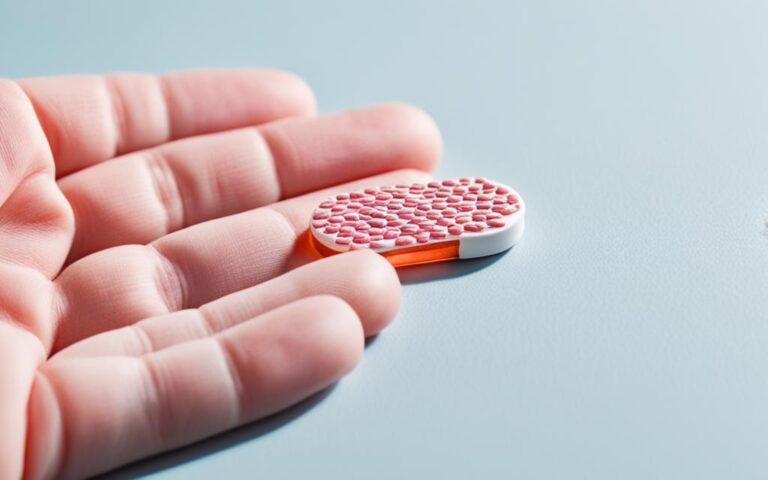Penicillin for cats: Uses and Benefits
Did you know that penicillin was the first antibiotic ever discovered? It plays a big role in helping cats fight off bacterial infections1. This antibiotic comes from fungus. It has been aiding our furry friends for many years, treating various bacterial illnesses. Penicillin can help with anything from problems in their breathing to issues with their skin.
Key Takeaways
- Penicillin is a natural antibiotic used to treat bacterial infections in cats and other animals.
- The injectable form, Penicillin G, is FDA-approved for use in cats to treat respiratory and skin infections.
- Penicillin works by preventing bacteria from creating a crucial part of their cell wall, leading to their weakening and death.
- Potential side effects in cats include gastrointestinal issues and rare allergic reactions.
- Proper dosage and administration, as directed by a veterinarian, are crucial to ensure the safe and effective use of penicillin in cats.
Table of Contents
What Is Penicillin?
Penicillin is a natural antibiotic that fights against harmful bacteria2. It stops these bad bacteria from making their cell walls correctly. This makes the bacteria weak and they eventually die2. Penicillin does a great job with certain types of bacteria, like Staphylococcus and Streptococcus2.
Understanding the Antibiotic Properties
Doctors use penicillin to help cats with many infections. These infections could be in the skin, the lungs, or even the gut2. It’s also good for keeping infections away from cats that have wounds or had surgery recently3.
FDA-Approved Forms for Veterinary Use
Penicillin comes in two main forms for pets. There’s an injection, and there are pills. The injection is best for bigger animals, like cows and horses. While pills are better for daily use in cats and dogs2.
| Medication | Concentration | Dosage for Cats | Withdrawal Period |
|---|---|---|---|
| Penicillin G Procaine Aqueous Suspension | 300,000 units per mL | 10,000 to 25,000 units per pound, 2-6 times daily2 | Not applicable for companion animals |
| Penicillin V (oral) | Not specified | 5 to 10 mg per pound, once daily2 | Not applicable for companion animals |
Most cats need penicillin for a week or two to fight the infection2. Yet, some might need it longer, depending on how they respond3.

Remember, penicillin might not mix well with some other drugs your cat takes. Let your vet know all the medications your cat is on4.
“Penicillin is a natural antibiotic that has been used for decades to treat a wide range of bacterial infections in both humans and animals, including cats.”
In short, penicillin is crucial for treating bacterial infections in cats. Knowing how it works and its types is essential for correct use and your cat’s safety423.
How Penicillin Works
Penicillin is a powerful antibiotic that stops bacteria from making an important part of their cell wall5. This method makes the bacteria’s walls weak. Then, it destroys the bacteria, getting rid of the infection5.
Mode of Action: Inhibiting Bacterial Cell Wall
Penicillin works mainly by blocking bacteria from adding to their wall5. The cell wall is key, giving bacteria shape and protecting them. When penicillin stops this process, the bacteria can’t grow strong. Their walls break and the bacteria die5.
“Penicillin prevents susceptible bacteria from creating a necessary part of their cell wall, thereby weakening and destroying the bacteria. This causes the bacteria to die.”
This way penicillin targets and attacks only the bad bacteria5. It keeps healthy cells safe. This makes penicillin an effective and safe antibiotic.

Penicillin’s special action on cell walls is very helpful in fighting infections in cats5. Vets who know how penicillin works can use it better. This helps treat bacterial infections in cats well5.
Penicillin Directions for Cats
Dosage and Administration Guidelines
Cats usually get Penicillin V, which is an oral suspension. This form needs to be mixed with water from a powder6. The dosage is often between 10 to 25 mg for every kilogram the cat weighs. This is given to cats every 12 hours6. How long a cat should take penicillin varies. It could be 3 to 5 days or even a few weeks. This depends on the illness, the cat’s weight, and other factors6.
Penicillin is best given to cats with an empty stomach. Yet, it’s okay to give it with a little food if the cat’s stomach gets upset7. Always follow the mixing instructions exactly. Shake the suspension well every time before using it7.
Handling Missed Doses
If you miss a dose, talk to the vet. They will tell you what to do. Sometimes, you might give the missed dose late, or they could say to skip it. Always stick to the regular dosing schedule and never give more than you should7.
“Proper administration and handling of penicillin are crucial for ensuring the safety and effectiveness of the treatment for your cat.”
After 14 days, throw away any penicillin you haven’t used. This is because the medicine can lose its strength over time7. By following the right dosing and handling steps for missed doses, you can help your cat get better.
Potential Side Effects and Precautions
Penicillin is often safe for cats, but it can have side effects. The usual problems include stomach upsets like vomiting, diarrhea, and not wanting to eat8. Some cats might be allergic to it. This can show up as a rash, fever, or trouble breathing8.
Remember, penicillin V in a pill form is bad for some pets. This means horses, rabbits, guinea pigs, gerbils, hamsters, and chinchillas should not take it. It could make them very sick with bad diarrhea8. For these pets, vets can suggest other antibiotics that are safe.
Gastrointestinal Issues
Gastrointestinal issues are common with penicillin use in cats. They may throw up or have diarrhea soon after taking it9. These problems can last longer in cats with certain health issues9. If this happens, talk to the vet right away.
Allergic Reactions
Penicillin allergies are rare but can be bad. Signs might be a rash, swelling, or trouble breathing9. If your pet has had a bad reaction to similar drugs before, don’t give them penicillin. The vet can suggest something else.
Species-Specific Risks
Penicillin V can be risky for some animals, causing dangerous diarrhea. This danger is for horses, rabbits, guinea pigs, gerbils, hamsters, and chinchillas8. Vets will choose other antibiotics for these pets to keep them safe from this effect.
Watch your cat closely while they are taking penicillin. If you see any bad signs, call the vet right away. Knowing about these side effects helps pet owners keep their cats safe and healthy during treatment8109.
Penicillin for cats: Uses and Benefits
Treating Bacterial Infections in Cats
Penicillin G is a common antibiotic used to fight bacterial infections in cats. It works well against wounds, skin conditions, tooth issues, and UTIs11. This medicine targets bacteria, not viruses or parasites, that make cats sick.
When your vet gives penicillin G, it tackles the infection directly11. A study showed amoxicillin, a similar drug, cleared infections in most cats with wounds or skin problems. It worked in 95.1% of the studied cats11. If amoxicillin didn’t work the first time, a second round could help11. It’s also better than penicillin G for healing UTIs in cats, as per the Merck Veterinary Manual11.
If your cat’s infection is bacterial, penicillin G is a good choice. It’s key to stick to the vet’s advice on how to give the medicine. This ensures the cat gets better without any issues12.
“Proper administration of antibiotics for cats under the guidance of a veterinarian is crucial to balancing benefits and risks.”13
Knowing when to use penicillin G can lead to better care for your cat in case of an infection111213. Talk to your vet to learn more about how it can help.
Storage and Handling
It’s vital to store and handle penicillin correctly for your cat’s health. Keep penicillin tablets and powders in a spot that’s not too hot or cold, between 68–77°F. For liquid penicillin, keep it in the fridge and throw it out after 14 days14. Always shut the container tightly to keep out moisture and light14.
Temperature and Light Requirements
Penicillin can lose its strength if it gets too hot, too cold, or sees too much sun. Always stick to the storage advice from the maker. Storing the liquid type in the fridge keeps it strong14. But, just warm it for 1-2 minutes before giving it to your cat14. Never use a microwave on it, as this could make it less effective14.
| Medication Form | Storage Requirement |
|---|---|
| Penicillin Tablets/Powders | Controlled room temperature (68–77°F) |
| Reconstituted Penicillin Suspension | Refrigerator (Discard after 14 days) |
Correctly giving penicillin to your cat keeps them safe. To make it easier, wrapping up your cat can help. Give liquid doses slowly, so your cat can swallow and breathe well14. Sometimes, cats spit out the medicine. Only re-dose if you’re sure they spat it all out14. After, show your cat love and maybe a treat to end on a good note14. Always wash the dropper or syringe and keep the medicine cold after using it14.
Adhering to these care steps for penicillin means your cat gets the most from it14.
Comparing Penicillin to Other Antibiotics
Veterinarians have many antibiotics for treating bacterial infections in cats. These include penicillin, amoxicillin, and more15. Each antibiotic is different and has special benefits. These need to be thought about when choosing the right treatment for a cat.
Penicillin has been helping pets for a long time16. But, its use can waste dose and be less effective when taken orally. Amoxicillin, especially with clavulanic acid as Clavamox, is better for some infections. It even helps fight against bacteria that resist penicillin by blocking their destruction enzymes.
Doctors often give penicillin once or twice daily. On the other hand, amoxicillin with Clavamox needs to be taken twice a day for better results16. Also, it’s important to keep in mind how long the medicine can be stored. Amoxicillin-clavulanic acid should be kept in the fridge and thrown away after 10 days of use. But penicillin stays effective longer even without refrigeration16.
| Antibiotic | Typical Dosage | Frequency | Key Advantages | Potential Drawbacks |
|---|---|---|---|---|
| Penicillin | Variable | 1-2 times daily | Time-tested, effective against a wide range of bacteria | Poor intestinal absorption, up to 70% of oral dose wasted16 |
| Amoxicillin-Clavulanic Acid (Clavamox) | 22 mg/kg | 2 times daily | Effective against Staphylococcus infections, addresses antibiotic resistance16 | Requires twice-daily dosing, shorter shelf life for oral suspension16 |
| Cephalexin | Variable | 1-2 times daily | Broad-spectrum activity, less risk of resistance development | May be less effective against some resistant bacteria |
| Clindamycin | 11 mg/kg | 2-3 times daily | Effective against anaerobic bacteria, good tissue penetration | Potential for gastrointestinal side effects, risk of Clostridium difficile infection |
| Doxycycline | 5-10 mg/kg | 1-2 times daily | Recommended first-line for feline acute bacterial upper respiratory infection15 | Potential for photosensitivity, gastrointestinal irritation |
| Metronidazole | Variable | 1-2 times daily | Effective against anaerobic bacteria, helpful for gastrointestinal conditions | Potential for neurological side effects, interactions with other medications |
| Enrofloxacin | 5 mg/kg | 1 time daily | Broad-spectrum activity, convenient once-daily dosing | Avoid use in chronic upper respiratory tract disease due to resistance concerns15 |
| Orbifloxacin | 2.5-7.5 mg/kg | 1 time daily | Broad-spectrum activity, convenient once-daily dosing | Potential for retinal toxicity, avoid use in chronic upper respiratory tract disease15 |
While penicillin is a sturdy antibiotic choice, other medicines might be better for specific illnesses. Drugs like amoxicillin, cephalexin, and doxycycline should also be considered for certain illnesses15. It’s crucial for veterinarians to weigh the pros and cons of each antibiotic for the best treatment for their feline patients.
Antibiotic Resistance Concerns
The issue of antibiotic-resistant bacteria is getting bigger in the pet healthcare field, showing a worrying trend17. These tough-to-treat infections can become expensive and need the use of harsh drugs18. Certain health issues put cats at risk of catching these tough infections like atopic dermatitis and diabetes mellitus18.
Antibiotic resistance is a big deal in both human and animal health. Research shows that bugs which resist medicines are becoming more common in pets19. These bugs don’t care if the medicine is for a dog or a person, they can spread everywhere17.
A key solution is to work closely with veterinarians to use antibiotics wisely17. Plus, everyone should focus on preventing these infections and keeping clean, like washing hands after petting animals17. Together, we can fight against antibiotic resistance in pets.
FAQ
What is penicillin?
How does penicillin work?
What are the FDA-approved forms of penicillin for use in cats?
How should penicillin be administered to cats?
What should I do if I miss a dose of penicillin for my cat?
What are the potential side effects of penicillin in cats?
Can penicillin be used to treat bacterial infections in cats?
How should penicillin be stored?
What other antibiotics may be used to treat bacterial infections in cats?
Are there any concerns about antibiotic resistance with penicillin?
Source Links
- Penicillin for Dogs and Cats
- Penicillin for Cats: Uses, Dosage, & Side Effects
- Penicillin for Cats: Uses, Dosage, & Side Effects
- Penicillin G Procaine Injection For Animals – Cat
- Antibiotics for Cats: Types and Possible Side Effects | Purina
- How Much Amoxicillin Is Safe to Give a Cat? – GoodRx
- Amoxicillin for cats: Dosage and Safety
- Amoxicillin-Clavulanic Acid | VCA Animal Hospitals
- Amoxicillin | VCA Animal Hospitals
- Common antibiotics for cats and their uses
- Amoxicillin for Cats
- Ampicillin for Dogs and Cats
- The Most Common Antibiotics for Cats: Learn What You’re Giving Your Cat
- Giving Liquid Medication to Cats | VCA Animal Hospitals
- What are the best practices for antibiotic use in feline upper respiratory tract disease?
- Amoxicillin-clavulanic acid (Clavamox, Augmentin, Clavacillin)
- Antibiotics and Your Pets: What You Should Know
- Antibiotic Resistant Bacterial Infections in Cats | VCA Animal Hospitals
- Antimicrobial resistance in bacteria isolated from cats and dogs from the Atlantic Provinces, Canada from 1994–2013

